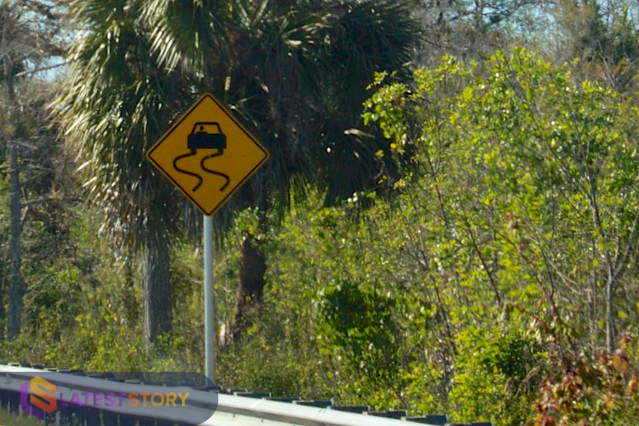Introduction
The slippery when wet road sign is one of the most crucial warning signs on roads worldwide. It alerts drivers about road conditions that may become hazardous when wet, helping them take necessary precautions. Understanding the slippery when wet road sign can prevent accidents and ensure safer driving in rainy or icy conditions.
In this article, we’ll explore the meaning of this sign, where it is typically found, why it is essential, and how to drive safely when encountering it.
What Does the Slippery When Wet Road Sign Mean?
The slippery when wet road sign is a warning sign that indicates the road surface may become slippery due to rain, ice, or other moisture. The sign usually features a black car with wavy skid marks underneath, displayed on a yellow background. This universal design helps drivers recognize and respond to the warning quickly.
Key Features of the Sign:
- Shape: Diamond-shaped
- Color: Yellow with black symbols
- Symbol: A car with skid marks
- Placement: Before curves, bridges, shaded areas, or places prone to water accumulation
This sign warns drivers to reduce speed, avoid sudden braking, and increase following distance when the road is wet.
Where is the Slippery When Wet Sign Commonly Found?
The slippery when wet road sign is placed in areas prone to hazardous conditions. Some common locations include:
1. Bridges and Overpasses
- Bridges and overpasses freeze faster than regular roads since they have air circulation underneath, making them more slippery in cold weather.
2. Sharp Turns and Curves
- Roads with sharp curves require caution, especially when wet, as tires can lose grip, increasing the risk of skidding.

3. Roads with Poor Drainage

3. Roads with Poor Drainage
- Areas where water accumulates easily create dangerous driving conditions and hydroplaning risks.
4. Shaded Areas
- Roads under trees or tunnels may stay damp longer, making them slippery even when other parts of the road are dry.
5. High-Traffic Intersections
- These areas experience frequent stopping and starting, which can lead to slick road conditions during rain.
Why is the Slippery When Wet Road Sign Important?
This warning sign plays a vital role in road safety by:
1. Preventing Accidents
- Alerts drivers to potential hazards, reducing the risk of skidding and hydroplaning.
2. Encouraging Defensive Driving
- Encourages motorists to adjust their speed and driving style to match road conditions.
3. Enhancing Public Awareness
- Reminds drivers to take extra precautions in specific areas, making roads safer for everyone.
4. Saving Lives
- Helps reduce fatal crashes caused by losing control of the vehicle on wet surfaces.
How to Drive Safely When You See a Slippery When Wet Sign
When encountering this sign, follow these driving tips:
1. Reduce Your Speed
- Drive 5-10 mph below the speed limit when roads are wet to maintain control of your vehicle.
2. Avoid Sudden Movements
- No sudden braking or sharp turns, as this increases the chances of losing traction.
3. Maintain a Safe Following Distance
- Keep at least a 3-4 second gap between your car and the vehicle ahead.
4. Use Proper Tires
- Ensure your tires have sufficient tread depth and are properly inflated for better grip on wet surfaces.
5. Be Cautious of Hydroplaning
- If you feel your car hydroplaning, ease off the accelerator and steer gently in the direction you want to go.
6. Turn on Headlights in Rain
- Improves visibility and alerts other drivers of your presence.
Legal Aspects of the Slippery When Wet Sign
Different countries have traffic regulations related to slippery roads:
- United States: Drivers are advised to reduce speed in wet conditions, and failure to do so may result in fines.
- United Kingdom: Road signs labeled “Slippery Road” warn of hazardous conditions.
- Australia & Canada: Similar warning signs are posted, and speed reductions are often enforced.
Ignoring these signs and causing an accident can lead to legal consequences such as fines, penalties, or loss of driving privileges.
Slippery When Wet Road Sign: A Quick Overview
| Feature | Description |
|---|---|
| Sign Shape | Diamond |
| Color | Yellow background with black symbols |
| Symbol | Car with wavy skid marks |
| Purpose | Warns drivers of slippery conditions when wet |
| Common Locations | Bridges, curves, intersections, shaded areas |
| Safety Tips | Reduce speed, avoid sudden braking, maintain tire traction |
| Legal Impact | Traffic fines, accident liability, increased insurance costs |

FAQs
1. What does the slippery when wet road sign mean?
It is a warning sign that alerts drivers that the road surface may become slippery when wet due to rain, ice, or moisture.
2. Where are slippery when wet road signs usually placed?
These signs are commonly found on bridges, sharp turns, roads with poor drainage, shaded areas, and high-traffic intersections.
3. What should I do when I see a slippery when wet sign?
You should reduce speed, avoid sudden braking, maintain a safe following distance, and ensure your tires are in good condition.
4. Can I get a fine for ignoring a slippery when wet sign?
While the sign itself does not carry a fine, causing an accident due to reckless driving in wet conditions can lead to fines, penalties, or legal consequences.
5. How do I avoid hydroplaning when roads are wet?
To avoid hydroplaning, reduce speed, avoid sudden turns, ensure proper tire inflation, and drive in the tracks left by vehicles ahead.
Conclusion
The slippery when wet road sign is a vital warning that helps drivers stay safe during wet conditions. By understanding its meaning, knowing where to find it, and following essential safety tips, drivers can prevent accidents and navigate slippery roads more safely. Always reduce speed, maintain control, and be aware of road conditions when you encounter this sign.
Stay cautious, drive safely, and respect road signs to ensure a safer journey!






